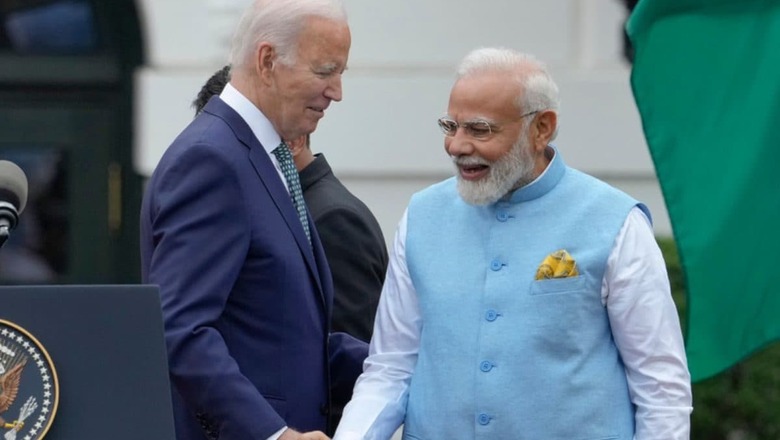
views
I have always believed that foreign policy is a matter of continuity and consensus, and not a subject of partisan political debate. National interest is not about political one-upmanship, but for the good of the nation as a whole. The serving Prime Minister, when abroad, does not represent his or her political party, but the country. In this spirit, I think there can be little doubt that Prime Minister Narendra Modi’s state visit to the US this month was a resounding success.
It is not my intention to go into the minutiae of what was achieved. The details are in the public realm. But to my mind, essentially the visit marked substantive progress in three key areas: Further consolidation of mutual trust, increased access to sensitive technology including through joint production in India, and greater appreciation of strategic congruence. Everything else follows from the sangam or confluence of these three factors.
For India and the USA to have reached this point in terms of mutual collaboration has taken decades to evolve. The beginnings were not fortuitous. During the Cold War years, America perceived India as being closer to the then Soviet Union, which was partly true, and was suspicious about the Non-Aligned movement, evaluating it as being too much under Soviet influence. Equally, the Indian leadership was left oriented, and there was a strong element of distrust with the ‘imperialist’ policies of the US. The Soviet Union too was more forthcoming in coming to the aid of India, especially in matters of defense, and large-scale economic projects.
On its part, America persisted in its strategic cultivation of Pakistan, which was far more accommodating to its defense interests. In fact, in 1971, when Bangladesh was created, President Nixon and Kissinger sent the US 7th fleet into the Indian Ocean, as a show of support for Pakistan. Following the end of the Cold War, residual suspicion and mistrust continued to hamstring closer bonds between India and the US.
Today, several independently evolving factors have created the circumstances for the new closeness between the world’s oldest and largest democracies. The most important new element is the invisible elephant in the room: China. An increasingly muscular and belligerent China is emerging as a greater threat to both India and America. It is openly challenging America’s assumed global hegemony, and openly flouting its vastly increased defense and economic prowess to threaten the entire Indo-Pacific region. In recent times, India too has seen the frozen peace on the Indo-Chinese border being repeatedly broken by unprovoked Chinese aggression. Against this visible threat, India and America have realised that strategic cooperation between each other is a necessary bulwark against the Chinese.
Secondly, the Russian-Ukrainian war, and the less than optimum performance of the Russian armed forces, has left India a little hesitant about its disproportionate reliance on Russia, especially in defence matters and cutting-edge technology which is so essential to today’s warfare. Russia is still a major defense partner, but over time, India has realised that over-dependence on one country reduces its options to procure strategic technology and other vital defence supplies which only Americans can provide.
The first major breakthrough in this process came during Dr Manmohan Singh’s PM ship, when in 2005 the Nuclear Deal was signed. It was the most momentous leap of faith in the future for both countries. It did not go unnoticed in the decision-making circles in the US, that an Indian government was willing to risk its survival and break ties with CPI(M), a major coalition partner, in order to take Indo-US relations to a qualitatively new level.
Thirdly, the old cliché that both India and the US, for all the individual flaws in their respective systems, belong to the democratic world and, therefore, have a natural congruence that brings them closer together, has finally hit home.
Fourthly, India’s economic progress, albeit slow, is now unquestionable. It is the fastest growing economy in the world today, and in spite of the unacceptable levels of inequality within, has the potential to be among the biggest markets for foreign investors. The speed of economic reforms may have been sluggish, and the ease of doing business still far from ideal, but India’s demographics, resourcefulness, cheap labour and democratic infrastructure make it a good candidate to replace China’s role as the outsourcing capital of the world.
Fifthly, the over four million strong Indian diaspora in the US, has finally come into its own. It is among the most economically powerful ethnic communities, and its captains dominate almost every branch of the high-tech infrastructure in America. Although in absolute terms still not numerically big, its sphere of influence is much greater, and it is an increasingly important factor even in elections within America.
All these factors put together accounted for the unprecedented success of PM Narendra Modi’s state visit. Of course, his own ability to build a rapport with American Presidents, and the hard work and preparation for the visit, were important factors, and due credit must be given to them. But ultimately, foreign policy is a continuum, and national interest is not a matter of party politics. So, when BJP spokespersons in their zealousness claim that all the credit must go to the current government, they are wrong. And when Opposition spokespersons swing to the other side of the spectrum, and say that all the real work was done in the past, and devalue Modi’s and his government’s contribution, they are wrong too.
The pursuit of national interest is a joint project, where the ruling party and the Opposition must come together.
The author is a former diplomat, an author and a politician. The views expressed in this article are those of the author and do not represent the stand of this publication.




















Comments
0 comment